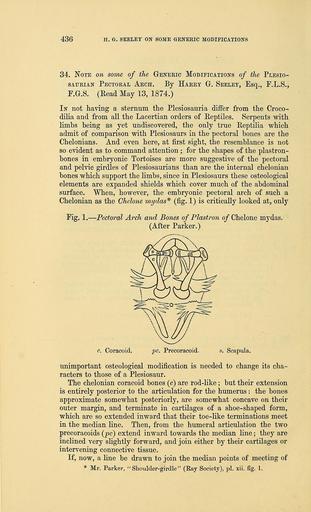MAKE A MEME
View Large Image

| View Original: | The_Quarterly_journal_of_the_Geological_Society_of_London_(12734064723).jpg (1945x3200) | |||
| Download: | Original | Medium | Small | Thumb |
| Courtesy of: | commons.wikimedia.org | More Like This | ||
| Keywords: The Quarterly journal of the Geological Society of London (12734064723).jpg OF THE PLESIOSAUEIAN PECTOKAX AECH 437 <br> the precoracoids and coracoids and a thin film of ossified connective <br> tissue extend over the interspace between them and unite these <br> bones respectively on each side of the animal a pair of coracoid <br> bones will be constituted similar in form position and relation to <br> those which characterize the Plesiosauria the only difference being <br> that in Plesiosaurs the precoracoid is connate with the coracoid as <br> in the Ostrich and many Lizards ; while in Chelonians it is connate <br> with the scapula s but much importance cannot be attached to the <br> condition of the precoracoid since no one will contend that Plesio- <br> saurs are either Lizards or Tortoises ; while among Amphibians the <br> precoracoid is a distinct bone so placed that it might combine indif- <br> ferently with coracoid or scapula <br> It is a noteworthy fact familiar to all who collect Plesiosaurian <br> coracoids from soft strata that the whole of this triangular inter- <br> space between the precoracoid and coracoid parts which I covered <br> in the Turtle with an imaginary thin ossification is liable to be <br> broken away in extricating the fossil ; and then there remains only <br> a curious bone forked from the humeral articular surface which <br> closely resembles the precoraco-coracoid portion of the chelonian <br> pectoral arch just described and in which only the precoracoid parts <br> similarly meet each other in the median line A beautiful example <br> of such a specimen from the Kimmeridge Clay presented by J C <br> Mansell-Pleydell Esq is exhibited in the British Museum fig 2 <br> Fig 2 ” Coracoids of Hurgenosanrus <br> Showing connation of coracoid c and precoracoid pc <br> Such a specimen goes far to justify an interpretation of the Plesio- <br> saurian coracoids as the combined coracoid and precoracoid bones <br> The Chelonian however has the form of its pectoral and pelvic <br> arches modified by the enormous amount of potential epiphysial <br> ossification which characterizes the subclass The epipleural carti- <br> lages of the Crocodile and the small epipleural bones of Hatteria <br> and of Birds are among Chelonians changed by potential growth <br> into ossifications in comparison with which the original pleural ele- <br> ments are small ; while they so grow and unite that an epipleural <br> skeleton is formed encased not in muscles as in most other ani- <br> mals but in representatives of muscles now converted in most <br> Chelonians into horny scutes corresponding with muscles in their <br> extension <br> It is at present standing over the remains of Megalosaurus without osteo- <br> logical determination and is placed upside down 35766358 110599 51125 Page 436 Text v 30 http //www biodiversitylibrary org/page/35766358 1874 Geological Society of London NameFound Hatteria NameConfirmed Hatteria NameBankID 211227 NameFound Megalosaurus NameConfirmed Megalosaurus EOLID 13154127 NameBankID 4234935 Biodiversity Heritage Library The Quarterly journal of the Geological Society of London v 30 1874 Geology Periodicals Smithsonian Libraries bhl page 35766358 dc identifier http //biodiversitylibrary org/page/35766358 smithsonian libraries Information field Flickr posted date ISOdate 2014-02-24 Check categories 2015 August 26 CC-BY-2 0 BioDivLibrary https //flickr com/photos/61021753 N02/12734064723 2015-08-26 19 57 30 cc-by-2 0 PD-old-70-1923 The Quarterly journal of the Geological Society of London 1874 Photos uploaded from Flickr by Fæ using a script | ||||